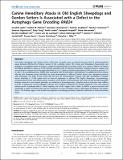Canine Hereditary Ataxia in Old English Sheepdogs and Gordon Setters Is Associated with a Defect in the Autophagy Gene Encoding RAB24
Author(s)
Agler, Caryline; Nielsen, Dahlia M.; Urkasemsin, Ganokon; Singleton, Andrew; Tonomura, Noriko; Sigurdsson, Snaevar; Tang, Ruqi; Linder, Keith; Arepalli, Sampath; Hernandez, Dena; Lindblad-Toh, Kerstin; van de Leemput, Joyce; Motsinger-Reif, Alison; O'Brien, Dennis P.; Bell, Jerold; Harris, Tonya; Steinberg, Steven; Olby, Natasha J.; ... Show more Show less
DownloadAgler-2014-Canine hereditary at.pdf (2.979Mb)
PUBLISHER_CC
Publisher with Creative Commons License
Creative Commons Attribution
Terms of use
Metadata
Show full item recordAbstract
Old English Sheepdogs and Gordon Setters suffer from a juvenile onset, autosomal recessive form of canine hereditary ataxia primarily affecting the Purkinje neuron of the cerebellar cortex. The clinical and histological characteristics are analogous to hereditary ataxias in humans. Linkage and genome-wide association studies on a cohort of related Old English Sheepdogs identified a region on CFA4 strongly associated with the disease phenotype. Targeted sequence capture and next generation sequencing of the region identified an A to C single nucleotide polymorphism (SNP) located at position 113 in exon 1 of an autophagy gene, RAB24, that segregated with the phenotype. Genotyping of six additional breeds of dogs affected with hereditary ataxia identified the same polymorphism in affected Gordon Setters that segregated perfectly with phenotype. The other breeds tested did not have the polymorphism. Genome-wide SNP genotyping of Gordon Setters identified a 1.9 MB region with an identical haplotype to affected Old English Sheepdogs. Histopathology, immunohistochemistry and ultrastructural evaluation of the brains of affected dogs from both breeds identified dramatic Purkinje neuron loss with axonal spheroids, accumulation of autophagosomes, ubiquitin positive inclusions and a diffuse increase in cytoplasmic neuronal ubiquitin staining. These findings recapitulate the changes reported in mice with induced neuron-specific autophagy defects. Taken together, our results suggest that a defect in RAB24, a gene associated with autophagy, is highly associated with and may contribute to canine hereditary ataxia in Old English Sheepdogs and Gordon Setters. This finding suggests that detailed investigation of autophagy pathways should be undertaken in human hereditary ataxia.
Date issued
2014-02Department
Massachusetts Institute of Technology. Department of Brain and Cognitive SciencesJournal
PLoS Genetics
Publisher
Public Library of Science
Citation
Agler, Caryline, Dahlia M. Nielsen, Ganokon Urkasemsin, Andrew Singleton, Noriko Tonomura, Snaevar Sigurdsson, Ruqi Tang, et al. “Canine Hereditary Ataxia in Old English Sheepdogs and Gordon Setters Is Associated with a Defect in the Autophagy Gene Encoding RAB24.” Edited by Tosso Leeb. PLoS Genet 10, no. 2 (February 6, 2014): e1003991.
Version: Final published version
ISSN
1553-7404